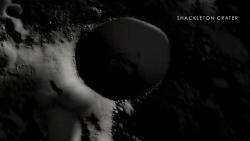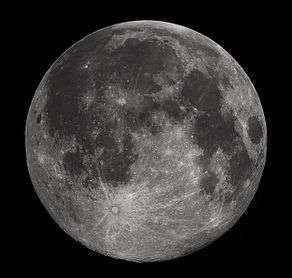Origin of the Moon

Origin of the Moon refers to any of the various explanations for the formation of the Moon, Earth's natural satellite. The leading theory has been the giant-impact hypothesis.[1][2] However, research continues on this matter, and there are a number of variations and alternatives.[1] Other proposed scenarios include captured body, fission, formed together (condensation theory), planetesimal collisions (formed from asteroid-like bodies), and collision theories.[3]
The standard giant-impact hypothesis suggests a Mars-sized body called Theia impacted Earth, creating a large debris ring around Earth, which then accreted to form the Moon. This collision also resulted in the 23.5° tilted axis of the earth, thus causing the seasons. [1] However, the Moon's oxygen isotopic ratios seem to be essentially identical to Earth's.[4] Oxygen isotopic ratios, which may be measured very precisely, yield a unique and distinct signature for each solar system body.[5] If Theia had been a separate protoplanet, it probably would have had a different oxygen isotopic signature from Earth, as would the ejected mixed material.[6] Also, the Moon's titanium isotope ratio (50Ti/47Ti) appears so close to the Earth's (within 4 ppm), that little if any of the colliding body's mass could likely have been part of the Moon.[7]
Formation
"One of the challenges to the longstanding theory of the collision, is that a Mars-sized impacting body, whose composition likely would have differed substantially from that of Earth, likely would have left Earth and the moon with different chemical compositions, which they are not."
—NASA[1]

Some theories have been stated that presume the Earth had no large moons early in the formation of the Solar System, 4.6 billion years ago, Earth being basically rock and lava. Theia, an early protoplanet the size of Mars, hit Earth in such a way that it ejected a considerable amount of material away from Earth. Some proportion of this ejecta escaped into space, but the rest consolidated into a single body in orbit about Earth, creating the Moon.
The hypothesis requires a collision between a body about 90% of the present size of Earth, and another the diameter of Mars (half of the terrestrial radius and a tenth of its mass). The colliding body has sometimes been referred to as Theia, the mother of Selene, the Moon goddess in Greek mythology. This size ratio is needed in order for the resulting system to have sufficient angular momentum to match the current orbital configuration. Such an impact would have put enough material into orbit around Earth to have eventually accumulated to form the Moon.
Computer simulations show a need for a glancing blow, which causes a portion of the collider to form a long arm of material that then shears off. The asymmetrical shape of the Earth following the collision then causes this material to settle into an orbit around the main mass. The energy involved in this collision is impressive: possibly trillions of tons of material would have been vaporized and melted. In parts of the Earth, the temperature would have risen to 10,000 °C (18,000 °F).
The Moon's relatively small iron core is explained by Theia's core accreting into that of Earth. The lack of volatiles in the lunar samples is also explained in part by the energy of the collision. The energy liberated during the reaccreation of material in orbit around Earth would have been sufficient to melt a large portion of the Moon, leading to the generation of a magma ocean.
The newly formed Moon orbited at about one-tenth the distance that it does today, and spiraled outward because of tidal friction transferring angular momentum from the rotations of both bodies to the Moon's orbital motion. Along the way, the Moon's rotation became tidally locked to Earth, so that one side of the Moon continually faces toward Earth. Also, the Moon would have collided with and incorporated any small pre-existing satellites of Earth, which would have shared the Earth's composition, including isotopic abundances. The geology of the Moon has since been more independent of the Earth. Although this hypothesis explains many aspects of the Earth–Moon system, there are still a few unresolved problems, such as the Moon's volatile elements not being as depleted as expected from such an energetic impact.[8]
Another issue is lunar and Earth isotope comparisons. In 2001, the most precise measurement yet of the isotopic signatures of lunar rocks was published.[4] Surprisingly, the Apollo lunar samples carried an isotopic signature identical to Earth rocks, but different from other Solar system bodies. Because most of the material that went into orbit to form the Moon was thought to come from Theia, this observation was unexpected. In 2007, researchers from Caltech showed that the likelihood of Theia having an identical isotopic signature as the Earth is very small (<1 percent).[9] Published in 2012, an analysis of titanium isotopes in Apollo lunar samples showed that the Moon has the same composition as Earth,[10] which conflicts with the Moon forming far from Earth's orbit.
To help resolve these problems, a new theory published in 2012 posits that two bodies—each five times the size of Mars—collided, then re-collided, forming a large disc of debris that eventually formed Earth and the Moon.[1] The paper was called “Forming a Moon with an Earth-like composition via a Giant Impact,” by R.M Canup.[1]
A 2012 study on the depletion of zinc isotopes on the Moon supported the giant-impact origin for Earth and the Moon.[11]
In 2013, a study was released that indicated that water in lunar magma is indistinguishable from carbonaceous chondrites and nearly the same as that of Earth in isotopic composition.[12][13]
The giant-impact hypothesis was again challenged in September 2013,[14] with a growing sense that lunar origins are more complicated.[15]
Another possibility is that before the giant impact, Earth had one or more normal satellites that shared its composition. Following the impact, the Moon formed closer to Earth than these satellites, and then spiraled outward, colliding with them. (If the Moon was more massive than the other satellites, its tidal effect on Earth would have been greater, making it spiral outward faster.) This led to the Moon being covered with material with the same composition as the satellites, and so Earth.
Other hypotheses
| Density[16] | |||||||
| Body | Density | ||||||
|---|---|---|---|---|---|---|---|
| Mercury | 5.4 g/cm3 | ||||||
| Venus | 5.2 g/cm3 | ||||||
| Earth | 5.5 g/cm3 | ||||||
| the Moon | 3.3 g/cm3 | ||||||
Capture
This hypothesis states that the Moon was captured by the Earth.[17] This was popular until the 1980s, and some things in favor of this model include the Moon's size, orbit, and tidal locking.[17]
One problem is understanding the capture mechanism.[17] A close encounter with Earth typically results in either collision or altered trajectories. For this hypothesis to function, there might have been a large atmosphere extended around the primitive Earth, which would be able to slow the movement of the Moon before it could escape. That hypothesis may also explain the irregular satellite orbits of Jupiter and Saturn.[18] In addition, this hypothesis has difficulty explaining the essentially identical oxygen isotope ratios of the two bodies.[4]
Fission
This is the now discredited hypothesis that an ancient, rapidly spinning Earth expelled a piece of its mass.[17] This was proposed by George Darwin (son of the famous biologist Charles Darwin) in the 1800s and retained some popularity until Apollo.[17] The Austrian geologist Otto Ampherer in 1925 also suggested the emerging of the Moon as cause for continental drift.[19]
It was proposed that the Pacific Ocean represented the scar of this event.[17] However, today it is known that the oceanic crust that makes up this ocean basin is relatively young, about 200 million years old or less, whereas the Moon is much older. The Moon does not consist of oceanic crust but of mantle material, which originated inside the proto-Earth in the Precambrian.[7] However, the assumption that the Pacific is not the result of lunar creation does not disprove the fission hypothesis. This hypothesis also cannot account for the angular momentum of the Earth–Moon system.

Accretion
The hypothesis of accretion suggests that the Earth and the Moon formed together as a double system from the primordial accretion disk of the Solar System.[20] The problem with this hypothesis is that it does not explain the angular momentum of the Earth-Moon system or why the Moon has a relatively small iron core compared to the Earth (25% of its radius compared to 50% for the Earth).[21]
Additional theories and studies

In 2011, it was theorized that a second moon existed 4.5 billion years ago, and later had an impact with the Moon, as a part of the accretion process in the formation of the Moon.[23]
One hypothesis, presented only as a possibility, was that the Earth took the Moon from Venus.[24]
See also
- Geology of the Moon
- Late heavy bombardment
- Lunar theory
- Other moons of Earth
- Lunar Reconnaissance Orbiter
- MoonRise (Lunar lander proposal)
Notes
References
- 1 2 3 4 5 6 NASA Lunar Scientists Develop New Theory on Earth and Moon Formation
- ↑ Staff (September 7, 2014). "Revisiting the Moon". New York Times. Retrieved September 8, 2014.
- ↑ Theories of Formation for the Moon
- 1 2 3 Wiechert, U.; Halliday, A. N.; Lee, D.-C.; Snyder, G. A.; Taylor, L. A.; Rumble, D. (October 2001). "Oxygen Isotopes and the Moon-Forming Giant Impact". Science. Science (journal). 294 (12): 345–348. Bibcode:2001Sci...294..345W. doi:10.1126/science.1063037. PMID 11598294. Retrieved 2009-07-05.
- ↑ Scott, Edward R. D. (December 3, 2001). "Oxygen Isotopes Give Clues to the Formation of Planets, Moons, and Asteroids". Planetary Science Research Discoveries (PSRD). Bibcode:2001psrd.reptE..55S. Retrieved 2010-03-19.
- ↑ Nield, Ted (September 2009). "Moonwalk" (PDF). Geological Society of London. p. 8. Retrieved 2010-03-01.
- 1 2 Zhang, Junjun; Nicolas Dauphas; Andrew M. Davis; Ingo Leya; Alexei Fedkin (25 March 2012). "The proto-Earth as a significant source of lunar material". Nature Geoscience. 5: 251–255. Bibcode:2012NatGe...5..251Z. doi:10.1038/ngeo1429.
- ↑ J. H. Jones. "TESTS OF THE GIANT IMPACT HYPOTHESIS" (PDF). Origin of the Earth and Moon Conference. Retrieved 2006-11-21.
- ↑ Pahlevan, Kaveh; Stevenson, David (October 2007). "Equilibration in the Aftermath of the Lunar-forming Giant Impact". EPSL. 262 (3-4): 438–449. arXiv:1012.5323
 . Bibcode:2007E&PSL.262..438P. doi:10.1016/j.epsl.2007.07.055.
. Bibcode:2007E&PSL.262..438P. doi:10.1016/j.epsl.2007.07.055. - ↑ Titanium Paternity Test Says Earth is the Moon's Only Parent (University of Chicago)
- ↑ Paniello, et al. - Zinc isotopic evidence for the origin of the Moon
- ↑ Earth-Moon: A Watery “Double-Planet”
- ↑ A. Saal, et al. - Hydrogen Isotopes in Lunar Volcanic Glasses and Melt Inclusions Reveal a Carbonaceous Chondrite Heritage
- ↑ Daniel Clery (11 October 2013). "Impact Theory Gets Whacked". Science. 342: 183. doi:10.1126/science.342.6155.183.
- ↑ Daniel Clery -Impact Theory Gets Whacked
- ↑ The Formation of the Moon
- 1 2 3 4 5 6 Lunar Origin
- ↑ Jewitt, David; Haghighipour, Nader (2007), "Irregular Satellites of the Planets: Products of Capture in the Early Solar System", Annual Review of Astronomy and Astrophysics, 45: 261–295, arXiv:astro-ph/0703059
 , Bibcode:2007ARA&A..45..261J, doi:10.1146/annurev.astro.44.051905.092459
, Bibcode:2007ARA&A..45..261J, doi:10.1146/annurev.astro.44.051905.092459 - ↑ Die Naturwissenschaften, July 1925 (in German)
- ↑ The Formation of the Moon burro.cwru.edu
- ↑ The Formation of the Moon burro.cwru.edu
- ↑ GSFC
- ↑ doi:10.1038/nature10289
- ↑ ,Did We Steal Our Moon From Venus? Is our planet a dirty thief?, Popular Science, 09.27.2013 at 5:07 pm
External links
- Lunar formation Case Western Reserve University
- The Once and Future Moon (September 28, 2012)
- Nature - Moon-forming impact theory rescued



